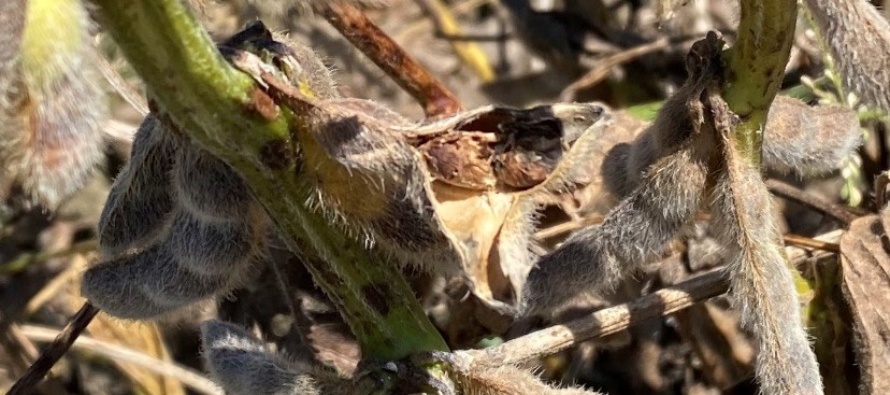Soybean Harvest Aid Considerations

Related Articles
- 2010 Soybean And Corn Variety Trial Data 3
- 2010 Row Crop Short Course Video Links 0
- Identifying Wheat Growth Stages using the Feekes Scale 4
Latest Tweets
As we move into September, some of the biggest topics in soybean have been harvest aid application and grain quality. Moderate to severe damage has been observed in soybean harvested following the weather that many areas of the state experienced during the week of August 22nd. Two big questions have followed this weather event. First, did the damage occur as a result of those acres having been treated with a harvest aid and second, should harvest aids be applied ahead of significant rain chances remaining in the 10 day forecast?
Question 1: Did the damage occur as a result of having already applied a harvest aid ahead of prolonged wet, cloudy weather?
The general observation has been that seed sprouting and damaged seed are evident in fields that were treated with a harvest aid ahead of the week of August 22 as well as in fields that were not treated. This question is one that we have tried to answer through research efforts as well. In a previous graduate student project, we evaluated yield and quality of untreated soybean compared to that of soybean treated with a harvest aid. Within this research project, multiple harvest delays were built in so that we could try to capture the yield and quality impact of both time between application and harvest as well as adverse weather conditions that can occur this time of year. To summarize, as time increased between application and actual harvest, issues such as shattering and lodging were prone to increase, but when damage occurred, it occurred equally between both harvest aid treated and untreated soybean.
Question 2: Should we apply harvest aids ahead of significant rain chances in the forecast?
This is a difficult question to answer. It could be argued that removing the leaves from the crop with the harvest aid might allow for better air flow and ultimately dry things out to get the combine into the field sooner after the rain moves out. But, on the other hand, if the application is made and it rains for several days straight, natural leaf senescence may have occurred by the time a machine could harvest anyway. If the decision is to apply the harvest aid, consider only treating the number of acres that harvest machinery can keep up with in the event that weather challenges continue.
As a quick review, the following are some of the products labeled for use as a harvest aid in soybean:
| paraquat at 0.125 to 0.25 lb ai/acre | Paraquat will provide desiccation of both weeds and soybean. The preferred application rate is 0.25 lb ai/acre. A nonionic surfactant (0.25% V/V) should be included. For paraquat, a 15 day preharvest interval is required.
|
| Sharpen at 1 to 2 fl oz/acre | Sharpen will provide desiccation of broadleaf weeds and soybean. The addition of a methylated seed oil (1% V/V) plus ammonium sulfate (1 to 2% W/V) is recommended for optimum desiccation. Application rates of 1.5 to 2 fl oz/acre are generally required when Sharpen is applied alone. This product has a 3 day preharvest interval.
|
| sodium chlorate at 6 lb ai/acre | Sodium chlorate will also provide desiccation of weeds and soybean. However, the level of activity from this application will depend on environmental conditions at the time of application. Keep in mind that sodium chlorate is a true desiccant and will physically draw moisture out of plant tissues and seed. With that in mind, sodium chlorate should be applied 7 to 10 days before harvest.
|
Additional products labeled for use as a harvest aid in soybean include Aim EC and glyphosate, both of which would be more suited for weed management in preparation for harvest rather than as a desiccant for the crop itself.




Let me tell You a sad story ! There are no comments yet, but You can be first one to comment this article.
Write a comment